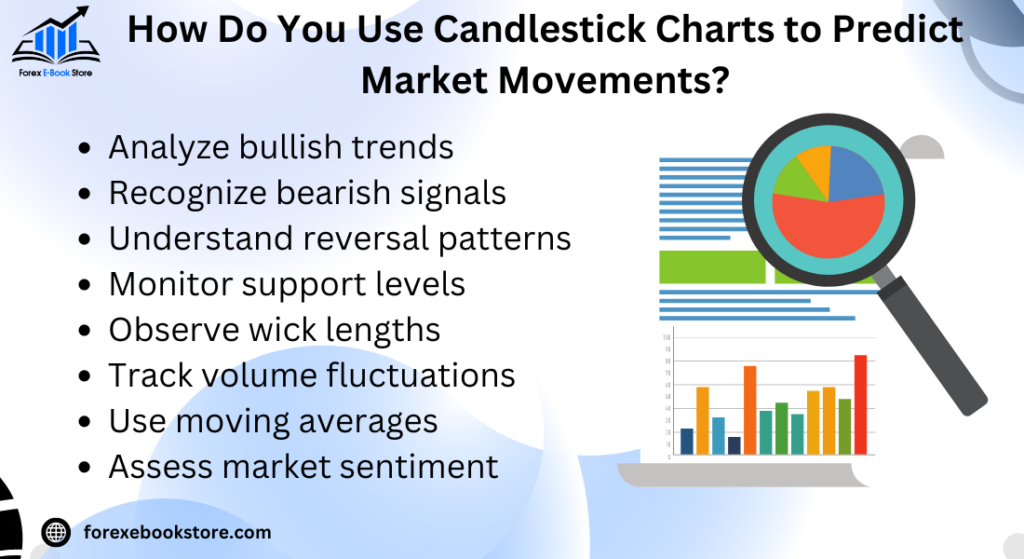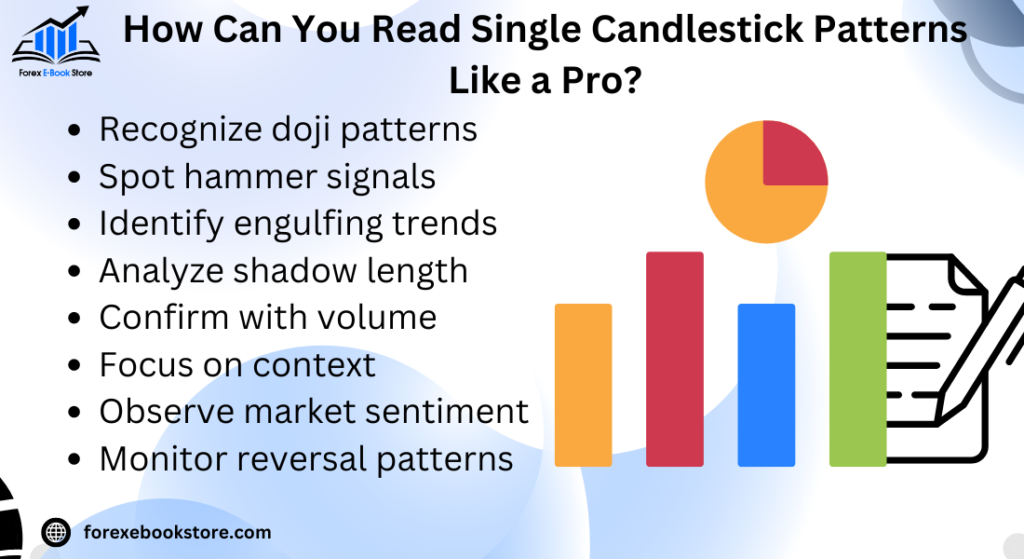Understanding candlestick charts is a vital skill for anyone looking to succeed in technical analysis and trading. These charts provide critical information about price movements in a visually intuitive format, allowing traders to spot trends, identify patterns, and make informed decisions. Whether you’re a beginner or an experienced trader, mastering the art of reading candlestick charts can significantly enhance your ability to predict market behavior and optimize your trading strategies.
In this guide, we’ll break down the fundamentals of candlestick chart analysis, explaining key components, patterns, and methods to interpret the market more effectively. By gaining a deep understanding of these charts, you’ll be better equipped to recognize opportunities, manage risk, and improve your overall trading performance.
Table of Contents
What Are Candlestick Charts, and Why Are They Important in Trading?
Candlestick charts are a popular tool in technical analysis used by traders to assess and predict market movements based on historical price data. They originated from Japan in the 18th century and have since become a cornerstone of modern trading, particularly in forex, stocks, and cryptocurrency markets. Each candlestick on the chart represents a specific time frame of price action, including the opening, closing, high, and low prices within that period.
Candlestick charts are important because they offer a visual representation of market sentiment, allowing traders to understand the psychology of buyers and sellers. Unlike traditional line charts, candlestick charts provide detailed insight into price volatility, helping traders identify patterns and make informed decisions. With a clear understanding of these charts, traders can recognize trends and potential reversal points, making them crucial for any trading strategy.
Key Benefits of Candlestick Charts:
- Easy to read and interpret
- Highlights price trends and momentum
- Helps in identifying reversals and continuation patterns
- Suitable for multiple time frames and markets (forex, stocks, crypto)
How Do Candlestick Charts Work: Understanding the Basics
Candlestick charts consist of individual candles that represent the price action of a trading instrument during a specified period (e.g., 1 minute, 5 minutes, 1 hour). Each candle displays four key price points: the opening price, closing price, high, and low for that period. The body of the candlestick shows the price difference between the opening and closing prices, while the wicks (or shadows) indicate the highest and lowest prices reached.
A bullish candlestick is typically colored green or white, showing that the closing price was higher than the opening price, indicating upward momentum. Conversely, a bearish candlestick is usually red or black, indicating that the closing price was lower than the opening price, signaling downward movement.
Candlestick Anatomy:
- Body: Represents the range between the opening and closing prices.
- Upper wick: Indicates the highest price point reached during the period.
- Lower wick: Reflects the lowest price point reached during the period.
- Color: Indicates bullish (green) or bearish (red) momentum.
By analyzing the size and shape of these components, traders can gain insights into market conditions and potential price direction. Long bodies suggest strong buying or selling pressure, while short bodies indicate consolidation or indecision in the market.
What Are the Key Components of a Candlestick?
A candlestick has several components that provide traders with crucial information about market activity during a specific time frame. Understanding these components is essential for accurate candlestick chart analysis.

The Body
The body of a candlestick represents the price range between the opening and closing prices. A long body indicates a significant price movement during that period, suggesting strong market sentiment, whether bullish or bearish. On the other hand, a short body suggests minimal price movement and potential market indecision.
The Wicks (Shadows)
The upper wick represents the highest price reached during the time frame, while the lower wick shows the lowest price. Long wicks can indicate price rejection at certain levels, often a sign of a potential reversal. For instance, if the upper wick is much longer than the body, it could suggest that sellers are pushing the price down despite earlier upward momentum.
The Color
The color of the candlestick reveals whether the market was bullish or bearish during the period. A green or white body indicates that the closing price was higher than the opening, showing bullish sentiment. Conversely, a red or black body suggests that the closing price was lower than the opening, reflecting bearish behavior.
Understanding these components allows traders to interpret market psychology, helping them make predictions about future price movements based on past behavior.
What Is the Difference Between a Bullish and Bearish Candlestick?
Bullish and bearish candlestick patterns are key indicators of market sentiment and potential price movement. Understanding the differences between these two types of candlesticks can help traders identify trends, make informed decisions, and forecast future price changes.
- Bullish Candlestick: A bullish candlestick indicates that the market is moving upward. It forms when the closing price is higher than the opening price, showing that buyers were in control during that trading period. Bullish candles are often depicted in green or white.
- Example: The Bullish Engulfing pattern, where a larger bullish candle completely engulfs a smaller bearish candle, signals a strong shift toward buyer dominance.
- Bearish Candlestick: A bearish candlestick represents a downward market trend. It occurs when the closing price is lower than the opening price, indicating that sellers dominated the market. Bearish candles are typically shown in red or black.
- Example: The Bearish Engulfing pattern forms when a large bearish candle engulfs a smaller bullish candle, suggesting a shift in control from buyers to sellers.
Key Differences:
- Bullish: Closing price > Opening price, usually green or white.
- Bearish: Closing price < Opening price, typically red or black.
How Can You Identify a Trend Using Candlestick Patterns?
Identifying trends using candlestick patterns is a fundamental aspect of technical analysis that helps traders predict future price movements. Certain candlestick patterns are key indicators of whether a trend will continue or reverse. The ability to spot these patterns can provide valuable insights into market behavior.
One common way to identify a trend continuation or reversal is by using reversal patterns like the Morning Star or Three White Soldiers. The Morning Star is a bullish reversal pattern that appears at the bottom of a downtrend and consists of three candles. It suggests that the market is shifting from bearish to bullish sentiment. On the other hand, Three White Soldiers is another bullish continuation pattern, which indicates strong upward momentum and the continuation of an uptrend after a brief pullback.
For bearish trends, patterns like the Shooting Star and Bearish Engulfing signal potential downward movements. The Shooting Star forms after an uptrend and indicates that buyers are losing control, while the Bearish Engulfing pattern occurs when a small bullish candle is followed by a larger bearish one, signaling a reversal in market sentiment.
Key Patterns for Trend Identification:
- Bullish Reversal: Morning Star, Hammer, Three White Soldiers
- Bearish Reversal: Shooting Star, Bearish Engulfing, Evening Star
- Continuation: Rising Three, Falling Three, Three White Soldiers
What Are the Most Common Candlestick Patterns Every Trader Should Know?
Several candlestick patterns are widely recognized for their reliability in forecasting price movements. Traders rely on these patterns to predict potential reversals or continuations in market trends. Here are some of the most common candlestick patterns that every trader should be familiar with:
- Hammer: This pattern appears after a downtrend and signals a potential reversal. The Hammer is characterized by a small body with a long lower shadow, indicating that although sellers pushed prices lower during the session, buyers managed to drive the price back near the opening level.
- Bullish Engulfing: A two-candle pattern where a small bearish candle is followed by a larger bullish one. This pattern suggests that buyers have overtaken sellers, often indicating a reversal from a downtrend to an uptrend.
- Shooting Star: Appearing at the top of an uptrend, the Shooting Star has a small body and a long upper shadow, signaling that buyers pushed the price higher but were met with strong selling pressure. It often foreshadows a bearish reversal.
Other Important Patterns:
- Doji: Indicates indecision in the market. If a Doji forms after a strong trend, it may signal a reversal.
- Evening Star: A bearish reversal pattern that occurs at the top of an uptrend.
- Piercing Line: A bullish reversal pattern formed by two candles, signaling a potential upward move after a downtrend.
How Do You Use Candlestick Charts to Predict Market Movements?
Using candlestick charts to predict market movements involves analyzing candlestick patterns and their relation to the overall trend. Each pattern tells a story of the battle between buyers and sellers, and certain patterns can suggest whether the price will rise, fall, or consolidate.

For instance, traders often look for Bullish Engulfing or Hammer patterns to predict an upward movement. These patterns indicate that buyers are gaining control, which could lead to higher prices. On the flip side, patterns like Bearish Engulfing or Shooting Star are used to predict downward movements, signaling that sellers have overtaken the market.
Traders also use multiple candlesticks to assess the market context. For example, a Three White Soldiers pattern—three consecutive bullish candles—indicates a strong upward trend, while a Three Black Crows pattern signals a strong downward movement.
Candlestick Patterns and Market Prediction:
- Reversal Patterns: Morning Star, Evening Star, Hammer, Shooting Star
- Continuation Patterns: Rising Three, Falling Three, Three White Soldiers, Three Black Crows
- Indecision Patterns: Doji, Spinning Top
By combining candlestick charts analysis with other technical indicators such as moving averages or RSI (Relative Strength Index), traders can make more informed predictions about market movements. This multi-faceted approach increases the accuracy of market forecasts and minimizes risk.
These strategies, rooted in understanding candlestick patterns, are crucial for improving trading performance.
What Is the Best Time Frame for Reading Candlestick Charts?
The best time frame for reading candlestick charts depends on your trading style, objectives, and the level of market volatility. Each time frame offers unique insights, whether you’re a short-term day trader or a long-term investor.
- Short-Term Time Frames (1-Minute, 5-Minute, 15-Minute):
- These are ideal for intraday traders who seek to capitalize on quick market movements. Traders using these time frames often benefit from multiple trading opportunities throughout the day but must also navigate increased noise and volatility, which can lead to false signals. Short-term charts provide a real-time snapshot of price fluctuations but require fast decision-making.
- Medium-Term Time Frames (Hourly, 4-Hour, Daily):
- For swing traders, the daily and 4-hour charts are popular as they allow traders to observe broader trends without the fast-paced nature of intraday charts. This time frame is effective for identifying more reliable candlestick patterns like the Bullish Engulfing or Evening Star, providing a clearer picture of market direction.
- Long-Term Time Frames (Weekly, Monthly):
- Position traders who hold trades for weeks, months, or even years favor these time frames. Candlestick patterns on longer-term charts are often more reliable, providing a panoramic view of market trends and major shifts in sentiment. While opportunities are less frequent, the signals carry greater weight for those looking to make significant, long-term decisions.
How Do Candlestick Patterns Compare to Other Technical Indicators?
Candlestick patterns provide an immediate visual insight into market sentiment and price action, but they are often most effective when combined with other technical indicators. While candlestick charts patterns show clear entry and exit signals based on price movement, other indicators can offer additional layers of confirmation.
- Volume Indicators: Volume data is frequently paired with candlestick patterns to confirm the strength of a trend. For instance, a Bullish Engulfing pattern followed by a spike in volume may indicate a stronger upward momentum.
- Moving Averages: Many traders combine candlestick charts patterns with moving averages (such as the 50-day or 200-day moving average) to identify long-term trends. Patterns like the Hammer can be validated when they appear near these key levels of support and resistance.
- RSI (Relative Strength Index): Candlestick patterns can also be used in conjunction with the RSI to gauge whether a market is overbought or oversold. For example, a Doji near an overbought RSI level could signal a potential reversal.
What Are the Common Mistakes Beginners Make When Reading Candlestick Charts?
Many beginner traders often misinterpret candlestick patterns due to inexperience or a lack of understanding of broader market context. Here are a few common mistakes:
- Relying Solely on Candlestick Patterns: One of the most common errors is using candlestick charts patterns in isolation. Patterns such as the Shooting Star or Hammer can provide strong signals, but without additional confirmation from other indicators (like volume or trendlines), these signals may lead to false expectations.
- Ignoring Time Frames: Beginners may also choose the wrong time frame for their strategy. For instance, using a 5-minute chart for long-term decisions can lead to poor outcomes due to the increased noise in shorter time frames.
- Misinterpreting Reversal Patterns: Patterns like the Evening Star or Doji are frequently misinterpreted. New traders might not recognize that these patterns require confirmation before entering or exiting a trade. Without the right confirmation, they might enter positions prematurely.
To avoid these pitfalls, it’s essential for beginners to study market context, combine candlestick charts patterns with other technical tools, and practice patience before making trades based on patterns alone.
How Can You Read Single Candlestick Patterns Like a Pro?
Single candlestick patterns offer quick insights into potential price reversals or continuations. Some of the most common patterns include Doji, Hammer, and Shooting Star. A Doji forms when the opening and closing prices are almost identical, indicating market indecision. Traders often view Doji as a sign that a reversal might be coming, but further confirmation is needed.

A Hammer is a bullish reversal pattern, where the body is small, and the lower wick is long, showing that sellers initially controlled the market but buyers stepped in to push the price up. Conversely, the Shooting Star is a bearish pattern with a small body and a long upper wick, signaling that the buyers were dominant initially, but sellers took over.
Tips for Reading Candlestick Patterns:
- Doji: Signals indecision; look for confirmation with the next candle.
- Hammer: Indicates bullish reversal; usually seen after a downtrend.
- Shooting Star: Suggests bearish reversal; typically forms after an uptrend.
Subheading: What Each Single Candlestick Pattern Tells You
- Doji: Market uncertainty; neutral pattern that requires confirmation.
- Hammer: Strong buying pressure at lower prices, potential bullish reversal.
- Shooting Star: Sudden selling pressure at higher prices, potential bearish reversal.
How Do Multiple Candlestick Patterns Reveal Trading Opportunities?
While single candlestick charts patterns provide quick insights, multiple candlestick patterns are more reliable as they reveal the overall market sentiment and trading opportunities. Patterns like Engulfing and Harami are powerful tools in identifying potential reversals or continuations. A Bullish Engulfing pattern occurs when a smaller bearish candle is followed by a larger bullish one, indicating that buyers are taking control. This is a strong signal for a potential upward trend.
A Bearish Harami, on the other hand, shows a larger bullish candle followed by a smaller bearish one, signaling a potential reversal from an uptrend to a downtrend. Understanding these multi-candle patterns helps traders make more informed decisions, especially in volatile markets.
Important Multi-Candlestick Patterns:
- Bullish Engulfing: Strong reversal signal, buyers overpower sellers.
- Bearish Harami: Indicates potential trend reversal to the downside.
Subheading: Leveraging Multi-Candlestick Patterns in Your Trading Strategy
- Engulfing Patterns: Use to identify strong trend reversals, especially after periods of market consolidation.
- Harami Patterns: Watch for them in extended trends; they often suggest weakening momentum.
By understanding and integrating these candlestick charts patterns into your analysis, you can better predict market movements and capitalize on trading opportunities.
Conclusion
Mastering the art of reading candlestick charts is essential for any trader looking to make informed decisions in the market. Candlestick patterns offer valuable insights into market sentiment, providing traders with a clear picture of potential price reversals or continuations. By understanding key patterns like Doji, Hammer, and Engulfing, traders can better predict market movements and adjust their strategies accordingly.
To enhance your analysis, combining candlestick patterns with other technical tools, such as Bollinger Bands, can provide even greater insight. Bollinger Bands help identify periods of high and low volatility, allowing traders to confirm signals seen on candlestick charts. Together, these two tools create a powerful strategy for navigating market trends with precision.












